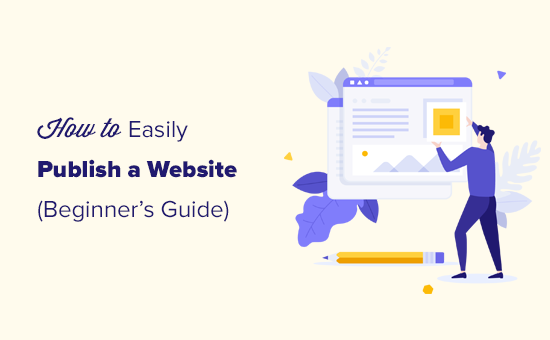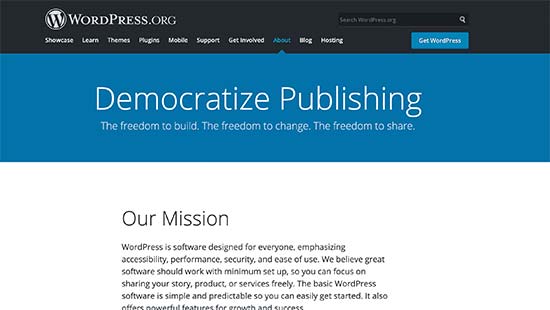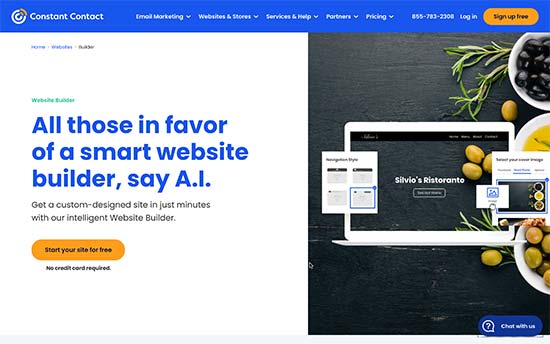Do you want to publish a website but are worried about technical stuff?
It is a misconception that you need to be a web designer or developer to code a website. There are many tools that make it super easy to put your website online without writing any code.
In this article, we’ll show you how to easily publish a website with step by step instructions.

Using a Website Builder to Publish a Website
Most beginners feel that they need to learn programming and web design skills to publish their websites.
It was true in the early days of the internet. At that time, businesses hired web developers or they had to learn coding skills to publish a website on their own.
However, things have changed over the years and technical skills are no longer a hurdle in publishing your content on the web.
These days, beginners, businesses, and even developers use website builders like WordPress to easily publish websites.
More than 69% of all websites on the internet are built using a website builder or CMS platform. This means, even developers don’t need to write code from scratch to publish a website.
These platforms allow anyone in the world to easily publish a website and put it on the internet. We’ll show you the easiest and most popular way to publish your website (no coding required).
1. Publish a Website with WordPress
WordPress is the most popular website builder on the market with the slogan ‘Democratize Publishing’. It is a free (as in freedom) and open-source software that anyone can use to build any type of website.

Over 39% of all websites on the internet are powered by WordPress.
To get started with WordPress, you’ll need a domain name (e.g. wpbeginner.com) and web hosting (this is where your website files are stored).
We recommend using Bluehost. They’re offering WPBeginner users a free domain name and a generous 60% discount on hosting ($2.75/month).
If you want to try an alternative, then we recommend SiteGround or any of these top WordPress hosting providers.
Next, you’ll need to install WordPress. We have a step by step WordPress installation tutorial that’ll walk you through the installation process.
Once you have installed WordPress, you’ll see the WordPress dashboard which looks like this.

Next, you need to install and activate the SeedProd plugin. For more details, see our step by step guide on how to install a WordPress plugin.
SeedProd is the best WordPress page builder plugin. It allows you to quickly publish professionally designed web pages for your website using a simple drag and drop user interface.

It is super easy to use and allows you to quickly publish your website with professional designs that are already optimized for sales, conversions, and SEO.
Alternatives to SeedProd
There are several popular page builder tools for WordPress. You can use any of the following to publish your website without any coding or design skills.
- Beaver Builder – A drag and drop WordPress website builder with advanced theme customizations
- Divi Builder – Another beginner friendly WordPress theme builder with tons of ready made templates
- Elementor – A powerful page builder tool for WordPress suitable for both beginners and developers
We believe WordPress is the most beginner-friendly platform to publish your website.
It is widely used and trusted by millions of beginners as well as big name brands like Microsoft, Facebook, and even US government uses WordPress to power the The White House website.
The best part about WordPress is that there are over 58,000 WordPress plugins that let you add just about any functionality to your website such as online store, contact form, SEO features, and more.
You can think of plugins like addons or apps for your iPhone. They make it easy for even first time users to configure and publish a website that search engines love and is easy to use for your customers.
2. Publish a Website with Contact Contact Website Builder
Constant Contact Website builder is an AI-powered website publishing tool suitable for beginners and small businesses.

If you don’t want to go through the trouble of purchasing hosting, domain name, and installing a web application software, then Constant Contact Website Builder would be the right tool for you.
It is an AI-powered website publishing tool that allows you to simply follow a step by step wizard. You’ll answer some questions and it will generate ideal layouts for you complete with the dummy content.
You can customize it in any way you want using a simple drag and drop interface. Once you’re done, simply click the Publish button.

The best part about using Constant Contact Website Builder is that you don’t need to worry about hosting or updates. You also get reliable support via chat, phone, and email.
If you simply want to publish a small business website or a quick online store, then it gets the job done with very little effort.
Alternatives to Constant Contact Website Builder
There are plenty of other fully-hosted, drag and drop website publishing platforms similar to Constant Contact. Following are a few hosted website builders picked by our expert team.
- Wix – a fast growing website builder platform that has all the features you’d need to build a website.
- Gator by HostGator – Fully hosted website builder by the folks behind HostGator. It comes with an intuitive drag and drop publisher with beautiful templates.
- Domain.com Website Builder – A fully hosted website builder with beautiful templates to quickly publish a website.
- GoDaddy – a large domain name registrar that also offer website builder tools.
All of these platforms are easy to use and allow you to publish your website without writing code.
3. Manually Publish Your Website
For those of you are who are eager to learn and willing to dive into basic HTML, CSS, and JavaScript, then this is the route you can take.
Note: If you don’t have any previous experience with these programming languages, then it may take you a while to get enough basic grip to code a reasonably presentable website and publish it online.
There are several online course platforms for students offering courses on web development for beginners. We recommend checking out the one offered by the CodeAcademy.
You can make a website on your computer, but you will still need a domain name (web address for your site) and website hosting service to publish it online.
All websites on the internet need hosting. It provides you storage on an online web server where you can upload and store your website files.
You can sign up with Bluehost which is one of the biggest hosting companies in the world. They are offering WPBeginner users a generous discount + free domain name + free SSL certificate.
Once you have signed up for a hosting account, you can upload the website files from your computer to your website by using an FTP client.
Alternatively, if your web hosting provider has cPanel, then you can use their built-in file manager for uploading your website in the public_html folder. This saves you from learning how to use the FTP server.
We hope this article helped you learn how to easily publish a website. You may also want to see our guide on how to create a professional business email address, and how to get a virtual business phone number for your small business.
If you liked this article, then please subscribe to our YouTube Channel for WordPress video tutorials. You can also find us on Twitter and Facebook.
The post Beginner’s Guide: How to Publish a Website in 2021 (Step by Step) appeared first on WPBeginner.











































